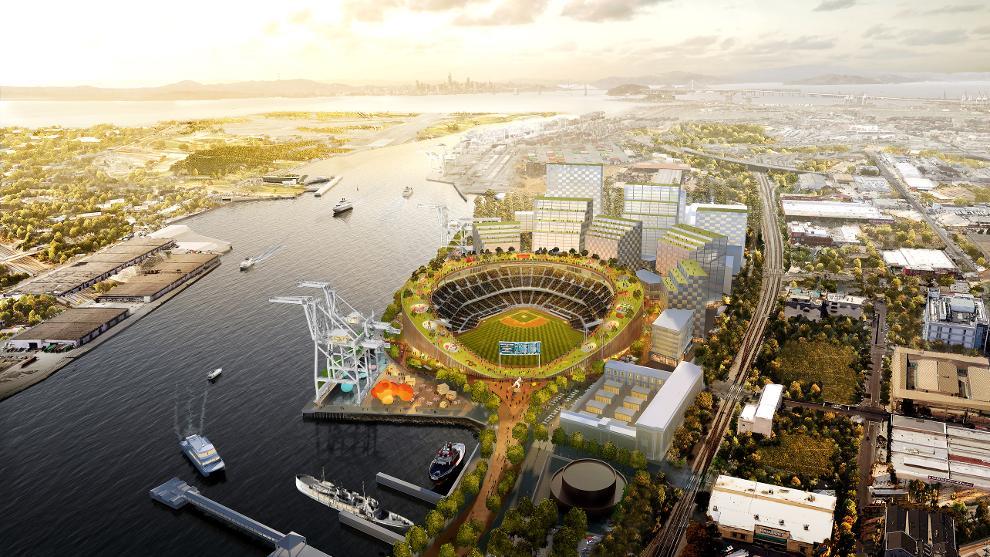
The Oakland A's want to build a new ballpark that will be integrated into the local community - not the typical project usually imposed on a neighborhood.
There is no end to studies that have concluded that building expensive stadiums for football or baseball teams are almost always a bad investment for cities. For the past two decades, we’ve seen the story play out time and time again: a franchise decides its stadium is outdated, the team’s owners threaten to move, civic leaders panic and then, the stadium is finally built. But while teams profit, cities often go into further debt, while local infrastructure and schools suffer.
We don’t hear much about this discussion because for the most part, all the stadiums have been built. But among the few baseball teams seeking another home, the Oakland A’s stand out for not just designing and building a new stadium, but one that will be integrated with the local community.
For a half century, the A’s have played at the Oakland Coliseum on Hegenberger Road and I-680 in the Fruitvale section of East Oakland. Many fans cherish this site for its four MLB championships and the scene of the Oscar-nominated Moneyball. Other fans, and many critics, remember the stadium, or "Mausoleum," for its perceived obsolescence and sewage backups.
The A’s say they want to turn the Coliseum site into a park surrounded by a mixed-use development that will include affordable housing.
And the team wants to move six miles northwest to what is now Howard Terminal in the port of Oakland. Plans call for a baseball-only stadium that could seat up to 34,000 fans. As with the case of the future Coliseum site, the stadium, projected to open in 2023, also promises to be surrounded with a mixed-use development with affordable housing, offices and public spaces.
The jewel of this development is an elevated park, designed to look like a futuristic green roof, which will wrap around the stadium. The A’s promise that this park will be open to the public, both on game days and during the off-season.
Critics say plunking a stadium in the middle of one of the busiest maritime ports in the country is a poorly conceived idea. The A’s have responded with a plan for a gondola that will ferry fans from nearby Jack London Square, which the team says would offer a safe, low-emissions form of transport while preventing any interference with the cargo ships in the bay or trains on land. Gondolas, however, have hardly caught on in the U.S. as public transport options outside of ski resorts. (The team and civic leaders in Oakland, however, could take inspiration from countries like Colombia that have included them in their public transportation infrastructure.)
The A’s also insist that this massive project will be entirely privately funded. In other words, there will be no burden on local taxpayers. Whether this is entirely true is open to debate; the city could be on the hook for neighborhood infrastructure improvements.
More local leaders are buying into this project, as Oakland is losing two of its major professional sports teams – the NFL’s Raiders are moving to Las Vegas next year, and the NBA’s Golden State Warriors will have new digs next season at a sparkling arena across the bay in San Francisco.
But not all stakeholders are thrilled at the prospect of the Oakland A's moving across town. Some residents of West Oakland see the new stadium project as another step in gentrification that will price low-income residents out of the neighborhood. Port workers see the stadium as a threat that would interfere with a working port while eliminating good-paying unionized jobs.
Nevertheless, the ideas the Oakland A’s have for this proposed new stadium stand out as this is a project meant to be part of a community - rather than the typical stadium project imposed on a neighborhood. Far too many stadiums were built with pledges of new tax revenues and jobs, only to find that the results didn’t match the promises. Sporting events also have a history of not creating a financial windfall, but instead a financial drain as local residents would rather stay home – or a new facility simply moves the money spent in one neighborhood to another.
But if the A’s can deliver on their commitment to affordable housing, and stay true to the team’s pledge that the Howard Terminal stadium will be a living part of the community instead of a massive empty shell most of the year, this ballpark could turn heads and redefine how sports teams build future stadiums in the 21st century.
Image credit: Oakland Athletics

Leon Kaye has written for 3p since 2010 and become executive editor in 2018. His previous work includes writing for the Guardian as well as other online and print publications. In addition, he's worked in sales executive roles within technology and financial research companies, as well as for a public relations firm, for which he consulted with one of the globe’s leading sustainability initiatives. Currently living in Central California, he’s traveled to 70-plus countries and has lived and worked in South Korea, the United Arab Emirates and Uruguay.
Leon’s an alum of Fresno State, the University of Maryland, Baltimore County and the University of Southern California's Marshall Business School. He enjoys traveling abroad as well as exploring California’s Central Coast and the Sierra Nevadas.














